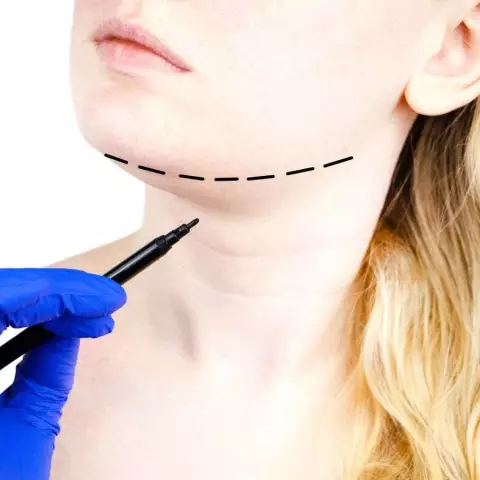- Author Rachel Wainwright [email protected].
- Public 2023-12-15 07:39.
- Last modified 2025-11-02 20:14.
Mentoplasty

The beauty of the face is made up of the harmonious proportions of all its features. And the chin plays an important role in this equation. But even if it is far from ideal, modern surgery can correct the deficiencies. Chin plastic surgeries are collectively referred to as mentoplasty.
Face proportions
The chin is a factor in determining the shape of the face. Its appearance depends on the lateral angle of the lower jaw and the degree of development of the base of the "mental triangle". With an angle of the lower jaw of more than 125 ° and an acute chin triangle, the face becomes oval or triangular. When the angle of the lower jaw is less than 125 °, the face appears rectangular or round.
If we analyze the reviews about mentoplasty of patients who have already undergone it, it is not difficult to notice that the operation is used mainly in extreme cases, when a chin defect noticeably distorts the proportions of the face. So, mentoplasty is indicated in cases where:
- A small sloping chin, in which the upper part of the face is visually enlarged;
- Heavy jutting chin;
- A too round and feminine chin in men or a square, masculine chin with a pronounced dimple in a woman;
- Double chin formed by fatty deposits;
- Asymmetrical chin;
- Chin deformed as a result of trauma;
- Chin with birth defects.
Before mentoplasty, modeling is always done, which allows you to evaluate the subsequent cosmetic effect of the operation. To do this, you will need an X-ray of the lower jaw, as well as a number of tests that confirm the readiness of the patient's body for surgical interventions.
Mentoplasty technique
Depending on the patient's ultimate goal, the following chin plastics techniques can be applied:
- Augmentation mentoplasty;
- Reducing mentoplasty;
- Double chin correction.
The operations are performed under local anesthesia and last from 30 minutes to 2.5 hours. An incision for mentoplasty is made either on the skin fold under the chin (external incision) or on the inside of the lower lip (internal incision). Each technique has its own characteristics.
Chin augmentation is a type of mentoplasty performed with insufficient chin volume. The surgeon pushes the lower jaw fragment forward. If this is not enough, then an implant is placed under the periosteum. Sometimes, to achieve a more perfect effect, the missing chin volume can be additionally filled with the patient's own fat - this method is called liposculpture.
Augmentation mentoplasty is indicated for microgenia - congenital, traumatic or postoperative defects of the lower jaw, due to which the chin looks small or sloping. It may seem to you that this operation is mainly used by men to give the face a more masculine look. However, judging by the reviews about mentoplasty, a small sloping chin does not suit women either. Augmentation mentoplasty allows you to balance facial features with silicone endoprostheses, bringing them closer to the classic ideal proportions.
Reducing mentoplasty is a bone-plastic transformation surgery. The surgeon removes or dissects the bone, displaces the lower fragment back and fixes it with cerclage sutures. Reducing mentoplasty is a rather lengthy operation, it takes about two hours.
This type of surgery is indicated if the chin is too heavy, disproportionately large. If this defect gives a certain piquancy to a man's face, then a woman's face with a large massive chin acquires masculine features. It is not surprising that reviews of reducing type mentoplasty are left mainly by women who seek to soften facial features.
Correction of a double chin is technically referred to as a reduction mentoplasty. However, the technique is somewhat different here. It is a lifting of the lower third of the face, which removes fatty deposits and sagging skin. When correcting a double chin, an incision is made from the outside. The surgeon removes excess fat and tissue in the neck area, which allows you to correct the facial contours.
Contraindications to mentoplasty and side effects
The operation is performed only on the formed bones, and since the bones of adolescents develop until the age of 23, it is not recommended to carry out the operation earlier than this age, unless it is about correcting serious birth defects or the consequences of accidents and severe injuries.
In addition, there are absolute contraindications related to the patient's state of health. These include some diseases of the thyroid gland, cardiovascular and infectious diseases, poor blood clotting, high hypertension, diabetes mellitus, violation of the integrity of the skin in the operation area, as well as a number of diseases of the oral cavity, if we are talking about an intraoral incision during surgery.
It is worth remembering that surgery may require lifestyle changes. For example, if an implant was used, there is always a risk of displacement. Therefore, after mentoplasty, it is recommended to avoid traumatic sports such as boxing. As with any surgical procedure, mentoplasty can cause infection, in which case it may be necessary to remove the implant to prevent the situation from getting worse.
Recovery after mentoplasty

Hospitalization is usually not required after surgery. Sometimes a patient can stay in the clinic for 24 hours if absolute rest is shown. Within 1-2 weeks after mentoplasty, the patient wears a fixation bandage that holds the tissues in the desired position - it is removed after the tissues are completely healed. The first three days you may feel discomfort, which can be eliminated by applying cold. Up to 3-5 days, the patient may feel minor pain, for the elimination of which the doctor may recommend an anesthetic drug. After mentoplasty, edema is not excluded, usually disappearing within 7-10 days. A week after the operation, the stitches are removed, and you can start working in 3-4 days. Judging by the reviews about mentoplasty, the recovery period largely depends on the type of operation and the state of the body.
Usually, after the procedure (most often if an implant was used), physical activity is not recommended, especially on the chin. Avoid heavy lifting or exercise for a month after surgery. In addition, in order to avoid mixing of the implant or bones, as well as severe pain, the patient is recommended at first to exclude loads on the jaw and to consume only liquid and soft foods - puree, juices.
Despite all the inconveniences associated with the recovery period, more and more men and women resort to mentoplasty. After all, the aesthetic result that the operation gives allows them to radically reconsider their attitude towards themselves, increase self-esteem and change the quality of life.
Found a mistake in the text? Select it and press Ctrl + Enter.






